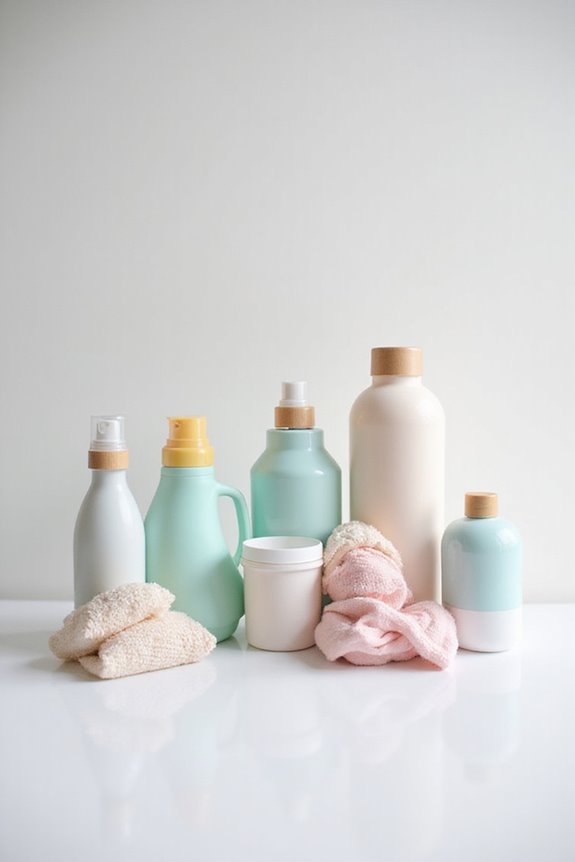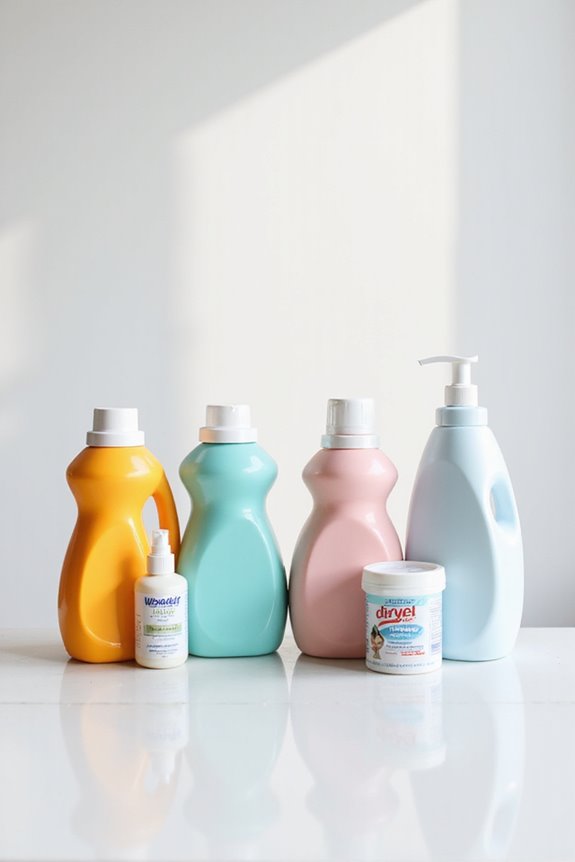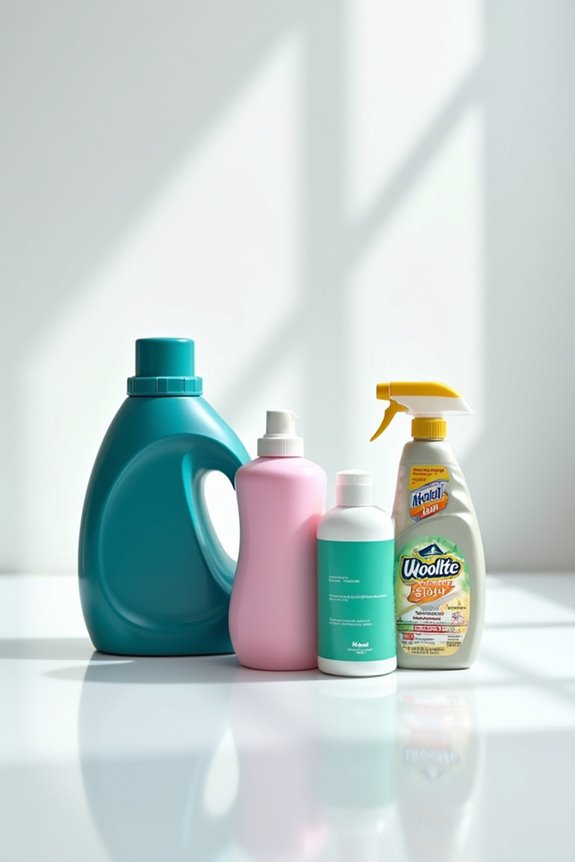Temperature really does affect how well laundry detergent performs. We noticed that hot water helps tackle grease and tough stains, while cold water works well for everyday loads and delicate fabrics. It’s all about finding the right balance. Some detergents are made to work better in cold temperatures, which can save energy and protect our clothes. If you’re curious, there’s more to uncover about seasonal washing tips and advanced detergent innovations!
Key Takeaways
- Water temperature significantly influences detergent effectiveness, with hot water enhancing cleaning for heavily soiled items and cold water being suitable for everyday loads.
- Cold water effectively removes specific stains like cooking grease, while hot water is better for dust and makeup on fabrics.
- Modern detergents are formulated to work efficiently in cold water, improving cleaning power without the need for high temperatures.
- Seasonal temperature variations can affect enzyme activity and cleaning performance, necessitating adjustments based on the time of year.
- Lower wash temperatures contribute to energy savings and fabric preservation while maintaining effective cleaning with the right detergent choice.
Understanding Enzyme Activation in Detergents
When we think about laundry detergents, we might not realize just how much science goes into making them effective, especially with enzymes playing an essential role. Enzyme stability is fundamental for keeping these hardworking molecules active during the wash cycle. They specifically target stains, like grease or protein, and break them down into smaller, water-soluble pieces, thanks to their catalytic efficiency.
It’s amazing how these enzymes can adapt to different stains without harming our clothes! We’ve all had that one stubborn stain, right? Well, enzymes are like tiny superheroes, swooping in to save the day. By understanding how enzymes activate and work best, we can make smarter choices in our laundry routine and keep our clothes looking fresh and clean. Additionally, using hypoallergenic detergents can further enhance skin safety while effectively cleaning your laundry.
The Impact of Water Temperature on Cleaning Efficiency

While we often think hot water is the go-to for tough stains, it’s captivating to discover how water temperature can really change the game in laundry efficiency. We’ve noticed that hot water excels at removing dust and makeup from cotton and polyester. However, cold water shines when tackling cooking grease and rust, especially on polyester fabrics. Remarkably, both temperatures handle coffee stains equally well. Choosing the right temperature affects cleaning performance based on fabric type and soil. Plus, modern detergents work wonders in cold water, thanks to advancements in chemistry. Cold water detergents ensure effective cleaning while conserving energy, making them a smart choice for eco-conscious consumers. So, while hot water packs a punch, we can save energy and costs by opting for cold washes when possible. Who knew laundry could be this strategic?
Seasonal Temperature Variations and Their Effects
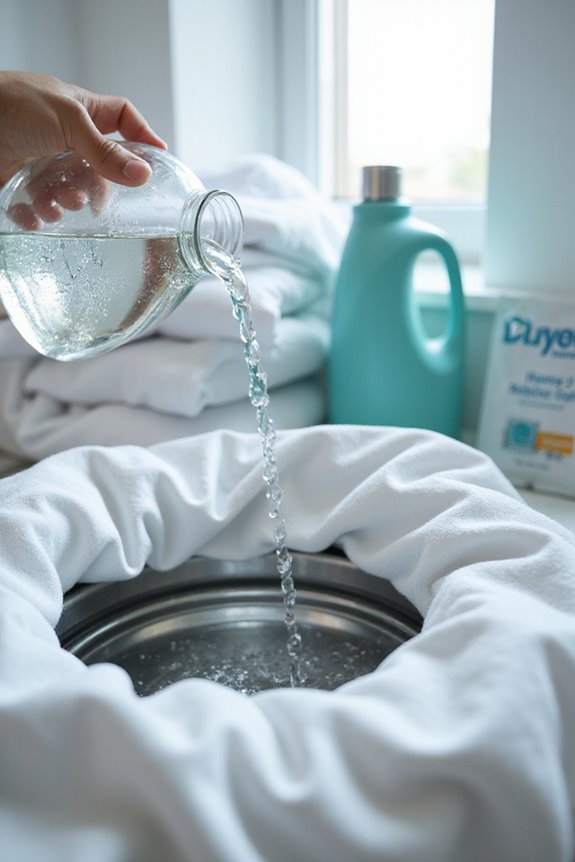
As we explore the world of laundry, it’s fascinating to contemplate how seasonal temperature changes affect our washing routines. During winter, incoming water can dip below 60°F (15.5°C), which reduces enzyme activity in our detergents. This means stubborn stains might stick around longer, especially on fabrics like cotton. On the flip side, warmer months can bring temperature extremes, which may also hinder cleaning power if water hits above 75°F. We’ve noticed that colder washes work surprisingly well for certain stains, like cooking grease on polyester. So, while we might love that hot wash for dirtier loads, we should consider the seasonal impacts on our detergent’s effectiveness. It’s a balancing act, but hey, that’s laundry for you! Additionally, many concentrated detergents are formulated to perform well even in cold water, ensuring that users can achieve effective cleaning regardless of seasonal temperature variations.
Low-Temperature Detergents: Innovations and Formulations
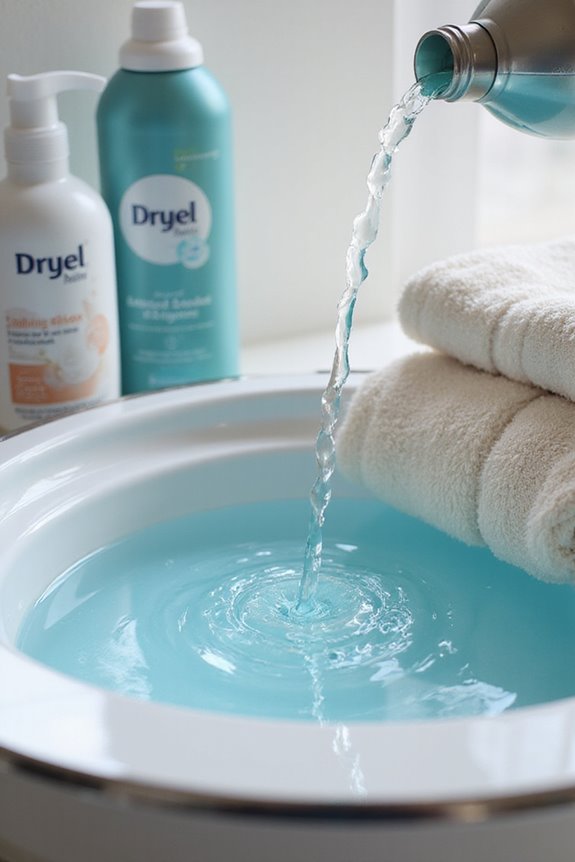
Low-temperature detergents have come a long way, and it’s exciting to see how innovations are making laundry easier for us all. With advancements in low temperature efficacy, these formulations are designed to work wonders even in colder water. We’ve noticed surfactant optimization in products that blend anionic surfactants, enhancing cleaning power without the need for hot water.
For instance, detergents like Aquanomic 2.0 Low-Temp Laundry Solid Break boost alkalinity to tackle tough stains. Plus, they’re eco-friendly, avoiding harsh chemicals that can be tough on our planet and our skin. Last week, we tried a new liquid detergent that left our linens soft and fresh, proving that low temps can still deliver high performance. Additionally, many of these detergents are made with eco-friendly ingredients, ensuring they are gentle on sensitive skin while still effectively cleaning clothes.
Temperature Considerations for Different Fabric Types

When it comes to washing our clothes, understanding the right temperature for different fabric types can save us from mishaps like shrinkage or fading. For delicate fabrics like wool and silk, we should stick to low temperatures, ideally between 20-30°C. This helps preserve their integrity and prevents shrinkage. Cotton and blends can handle a bit more heat, around 40°C, which works wonders for hygiene and stain removal. However, we must be careful with hot water, as it can cause fading. Meanwhile, synthetic fabrics prefer warm water (30-40°C) to keep their fibers intact. It’s important to remember that using the right fabric temperature not only protects our clothes but also keeps them looking fresh and vibrant, especially when paired with color protection features that help maintain the vibrancy of dark textiles.
The Role of Detergent Type and Concentration
Choosing the right detergent isn’t just about grabbing the first bottle off the shelf; it’s a key factor that can make or break our laundry day. The type of detergent we use and its concentration can really impact cleaning performance. For example, high-efficiency (HE) detergents are designed for lower water volumes and temperatures. They maintain cleaning without harming our fabrics. Plus, the surfactant structure in these detergents, especially anionic surfactants, matters. They need the right chain length to work effectively in cold water. Also, we should be mindful of detergent viscosity—thicker isn’t always better. If we use too much, it can leave residue on our clothes. So, let’s choose wisely for effective and efficient laundry! Additionally, hypoallergenic options like 9 Elements and Plant-Based Laundry Detergent cater to those with sensitive skin, enhancing the overall laundry experience.
Balancing Energy Savings With Cleaning Performance
Finding that sweet spot between energy savings and effective cleaning can feel like a juggling act. We all want our clothes to come out fresh, but heating water can hike up energy costs. By using lower temperatures, like 30°C instead of 40°C, we can boost energy efficiency without sacrificing too much cleaning power. It’s essential to choose the right detergent, especially those formulated for cold washes. They help maintain that cleaning balance we all seek. Plus, washing at lower temperatures can extend the life of our clothes. Sure, some stains might need a little extra heat, but many can still be tackled effectively in cold water. So, let’s find that balance and save some bucks while we’re at it!
Advancements in Sustainable Detergent Development
As we plunge into the world of sustainable detergent development, it’s exciting to see how innovations are reshaping our laundry routines. We’re now seeing detergents made from bio-based ingredients like cellulose nanofibers and corn protein, which tackle stains just as well as traditional options. These plant-based enzymes also help save water, cutting usage by up to 20%. Plus, let’s not forget the sustainable packaging! Brands are stepping up with biodegradable materials and bottles made from recycled plastics. It’s like giving our laundry a green makeover! We can feel good knowing that our choices help reduce plastic waste while still getting our clothes clean. Who knew doing laundry could be this eco-friendly and fun?
Best Practices for Optimal Laundry Results
When we think about getting our laundry done right, it’s easy to overlook how temperature plays a crucial role in the effectiveness of our detergents. Many laundry myths suggest that hot water is always best, but that’s not true for every fabric. For heavily soiled items, hot water can really boost cleaning power, while cold water does wonders for everyday loads and helps preserve fabric care.
We should also remember that modern detergents are designed to work well at lower temperatures. So, let’s adapt our washing practices seasonally. By adjusting water temperatures and understanding our fabrics, we can maximize cleaning results while being kind to our clothes—and even save some energy along the way!
Frequently Asked Questions
Can Hot Water Damage Delicate Fabrics During Washing?
We’ve all seen delicate fabrics shrink like a wilting flower in hot water. To protect our cherished garments, we should prioritize proper fabric care, avoiding heat to prevent damage and prolong their beauty.
How Often Should I Clean My Washing Machine?
We should aim for monthly washing machine maintenance to keep everything fresh and clean. If we use it regularly, we can even schedule a deep clean every six months or sooner for heavily soiled loads.
Do Different Stains Require Specific Washing Temperatures?
Did you know that up to 90% of stains can be removed more effectively with the right temperature? We should follow temperature guidelines for each stain type to guarantee ideal stain removal from our laundry.
Is It Necessary to Pre-Soak Clothes Before Washing?
We believe pre-soaking clothes can greatly enhance cleaning effectiveness, especially for stubborn stains. While pre-soak benefits are clear, alternatives like modern washing machines and DIY methods also offer great options for effective laundry care.
Can Using Too Much Detergent Affect Cleaning Performance?
We’ve all experienced it—using too much detergent can actually harm cleaning efficacy. High detergent concentration leads to suds overload, trapping dirt and leaving clothes less clean, so let’s stick to recommended amounts for better results.



